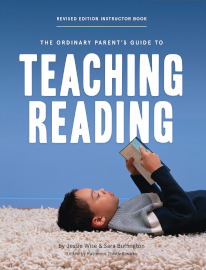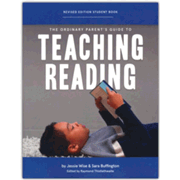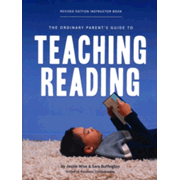The Ordinary Parent's Guide to Teaching Reading (revised edition) offers an inexpensive but thorough approach to teaching reading. The course consists of a student book and an instructor book. Both are available as printed books and PDFs.
The only extras you need along with this course are word cards and a magnetic board with alphabet letters or tiles. You can easily make the word cards yourself, or you can purchase them from the publisher. (The authors also recommend having a second magnetic board for organizing letters not being used.). The Ordinary Parent's Guide to Teaching Reading: Audio Companion to Lesson 1-26, is an optional resource that might help parents with pronunciation.
The program is multisensory in that it has children hear, say, and see sounds and words. In addition, working with magnetic tiles or another form of movable alphabet adds a tactile dimension to learning that is very helpful for young children.
Daily lesson plans are scripted with detailed instructions for what to say and do. This makes it very easy for parents to teach, even if they don't know phonics themselves! The instructor book builds plenty of repetition into the lessons. Frequently it says, “Let’s read some words that begin with the bl consonant blend. First I will read each word. Then we will read that same word together. Then you will read that word by yourself” (Instructor Book, p. 144). This same instruction, or something very similar, occurs almost 100 times, changing only the skill to be learned each time. The scripting provides security, but it can also feel too predictable and repetitive. (You might sometimes preview the lesson, pick up the concepts to be taught, then teach in a more natural fashion.)
In the first edition of the course, everything was in one book used by both parent and child, which made it difficult for children to focus on their material and also made it difficult to teach more than one child at a time. Now in the revised edition, any text that the student needs to read or interact with is in the instructor book. The student content appears in the revised instructor book in a much smaller font than the one used in the student book. I highly recommend using the student book because of the size of the font if for no other reason.
The student book includes plenty of reading practice in the form of individual words and sentences. Some of the sentences actually go together to make short stories even though they are presented on separate lines rather than in paragraphs. No readers are required, but you still might want to use phonetic readers to provide additional practice with some concepts as well as to introduce multi-page stories to children.
The approach used in this program is “explicit phonics.” It begins with the identification of the individual letters and their most-common sounds. Lesson 27 begins to teach blending, starting with vowel-consonant combinations such as at, ad, an, and am. Three-letter words are introduced through word families, such as pad, had, mad, dad, sad, and bad in Lesson 30. This approach is used throughout the course, even when it teaches longer words such as ought, bought, fought, sought, thought, and brought in Lesson 140.
It will probably take at least a few years to complete this course since it covers concepts typically taught from kindergarten through about fourth or fifth grade, including plurals, syllables, contractions, possessives, compound words, words with prefixes (e.g., re, en, tri, and sub), homonyms, homophones, and homographs. Toward the end of the course, students read words such as partial, feudal, lieutenant, and antique. And they read sentences, such as “The water in the picturesque mountain lake appears opaque and turquoise” in lesson 224 and “The extraterrestrial creature wanted to do some interplanetary space travel” in Lesson 230. The program really goes beyond most other reading programs used with young children. You might use it for a few years, then pause to allow your child to solidify the reading skills acquired thus far. Then you can gradually introduce the advanced concepts as they are ready.
Continual review is built into the lessons, using a process the authors describe as “Two Review and One New.” You will mark with sticky notes the lessons that have words needing review. At the beginning of many lessons, the instructions say, “Don’t forget to do the ‘Two Review and One New’!” At that point, you will review one of the lessons marked with a sticky note plus the lesson just completed. These two reviews are done before introducing the new concept.
The authors recommend starting to teach reading to children younger than kindergarten if possible. If you do so, take as much time as you need to work through the lessons, probably moving at a slower pace than you would with an older child. This program should also work with older children who never learned phonics.
I like the way the authors have arranged the book. You can read the two-page “How to Use this Curriculum” and then jump right into the lessons. But if you want a little more information, you can go to the back of the book and read through the "Information for Parents" sections. The first of these sections is a goldmine of practical suggestions for "Preparing a Young Child to be a Reader." "Managing the Reading Session" offers teaching tips. "Encouraging a Child to be a Reader" and "Remedial Reading with an Older Student" add more specific tips regarding those topics. "Questions and Answers for the Ordinary Parent" address questions that often arise, such as “How quickly should I move through the book?” and “How will I know if my student is dyslexic?”
The Ordinary Parent's Guide does not try to teach writing or spelling. The authors believe that instruction in these skill areas should be taught separately to avoid overwhelming the child.
Summary
While some might find The Ordinary Parent's Guide to Teaching Reading overly structured, it provides a solid phonics program that is very affordable and is likely to be a close-to-perfect option for many parents.













